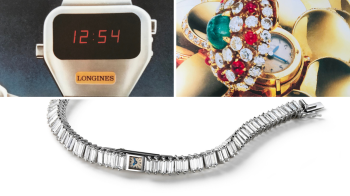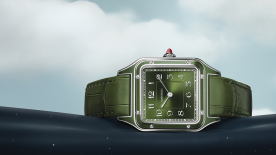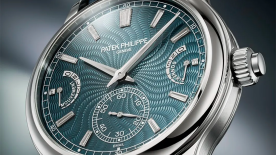We’re often told that fashion is generational, and also that there’s no point arguing about taste. But there is one fashion about which everyone currently seems to agree: vintage. The enthusiasm of watch brands, and therefore their clients (or perhaps it’s the other way around?) seems in no danger of dimming.
Watches of seduction are no exception. Our parents’ conception of glamorous watches is a long way from 21st-century ideas. After WWII, the wristwatch escaped its utilitarian shackles, creativity was unleashed and design took the upper hand. The most long-established houses set the tone: Audemars Piguet, Cartier, Eterna, Girard-Perregaux, Jaeger-LeCoultre, Longines, Patek Philippe and Vacheron Constantin, among others.
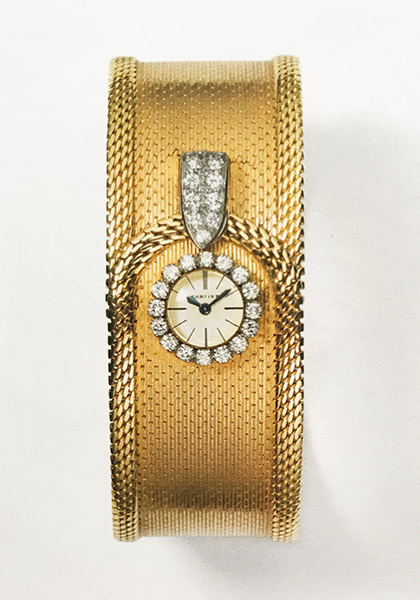
The 1960s: understated three-handed glamour
Each watchmaker has its speciality. Van Cleef & Arpels and Cartier, for example, exploited their jewellers’ credentials by working with gold, diamonds, platinum and precious gems, producing some extremely sophisticated creations. The same went for Jaeger-LeCoultre with its Cal. 101, the driver of a number of highly prestigious jewellery watches. For men, the iconic Tank by Cartier laid the foundations of chic and elegant styling for men, which was later adopted by women.

Generally speaking, the glamour watch remained understated and, at least as far as mass market products were concerned, circular and with a diameter that rarely exceeded 36 mm: Zenith, Movado, Longines (the Flagship model, recently reissued) and Omega (with the exception of the Constellation “Pie Pan” with its unusual 12-sided dial). The popularity of glamour watches for women began to rise, but they had no distinctive features – they were generally men’s watches, but in a smaller size. Kelton, an iconic brand of the decade, marketed its wares under a slogan that would become famous: “You change, change your Kelton”. The lines between glamour watch and fashion watch were beginning to blur.

The 1970s: unbridled design and quartz
The 1970s marked a turning point that probably had its origins in May 1968. Shapes became more flexible, and the notion of glamour itself became more playful. The ubiquity of quartz was certainly a factor. The smaller movements made it possible to explore geometries that would have been impossible with a mechanical calibre. Another major change for the glamour watch was that models for women were no longer merely versions of men’s watches (only smaller and sometimes with diamonds). Tissot, for instance, explored new formats in 1976 with its Stylist range, whose name immediately sums up the more expansive definition of chic.
The ’70s were also marked by the imprint of one designer in particular: Gérald Genta. He designed the Royal Oak in 1972, and its octagonal design set a new standard. Girard-Perregaux unveiled the highly inspired Laureato in 1975, but didn’t stop there: it was also one of the first watchmakers to invest in quartz (Quartz 1970). It was possible to be sleek, sexy and high-tech! Eterna also played around with different shapes and quartz movements, in particular with the Espada, which epitomised the era’s perception of glamour: not round, very slim, verging on the ultra-thin. It was also the age of integrated bracelets and the very first LEDs, a vision expressed by Longines in 1976, alongside liquid crystal displays. It might not have been particularly glamorous, but for the time, it was devastatingly fashionable!

The polarisation of the 1980s
The 1980s marked a schism in the world of the glamour watch. The “chic” watch parted company from the “cool” watch. In fact, the split was largely along generational lines. The “chic glamour” watches stampeded back to yellow gold, often deployed in combination with steel. Two-tone watches ruled the ’80s. The movement was irrelevant: what mattered were the looks, and quartz was king. But there was one notable exception: the Golden Bridge movement designed by Vincent Calabrese, a slender in-line mechanism and a major horological achievement. It remains in Corum’s collections today, and is still unique – an icon of glamour cherished by men and women for 40 years.
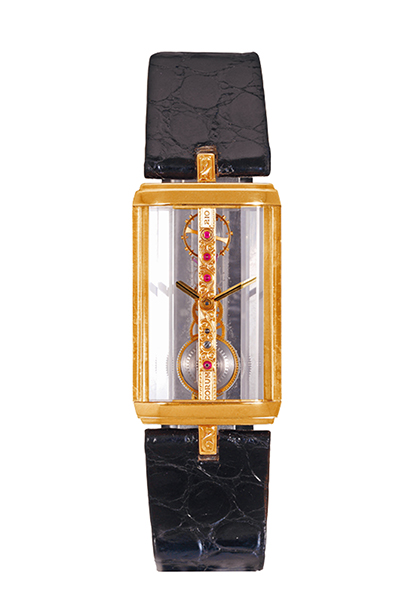
“Cool glamour” was at the opposite end of the spectrum. In the 1980s it was synonymous with one name: Swatch. The world’s most famous plastic watch was sexy, irreverent and uncomplicated. It also harked back to a concept that would have been familiar to the older generation: in the ’80s, you changed your Swatch like your parents changed their Kelton back in the 60s!
The 90s: a transition towards a new watchmaking century
The last decade of the century was not a period of unrestrained creativity. After the unbridled ’70s and the quartz-dominated ’80s, the 1990s marked a decade of treading water. Glamour meant bling-bling, and plenty of gold. Cash was king, and Tissot and Corum drew inspiration for their timepieces from actual money – Corum’s Coins are still in production.
Quartz continued to dominate, but its selling points were its small size, ease of maintenance and low cost, rather than innovation per se, since the technology had now become commonplace. But the uncommon, in the shape of fine mechanical watchmaking, gradually began to reassert itself. The tide began to turn in 1990, with the rebirth of Lange & Söhne, and Panerai’s opening to the public in 1993, followed by the emergence of the tourbillon as an object of desire, igniting the passions of collectors around the globe.
